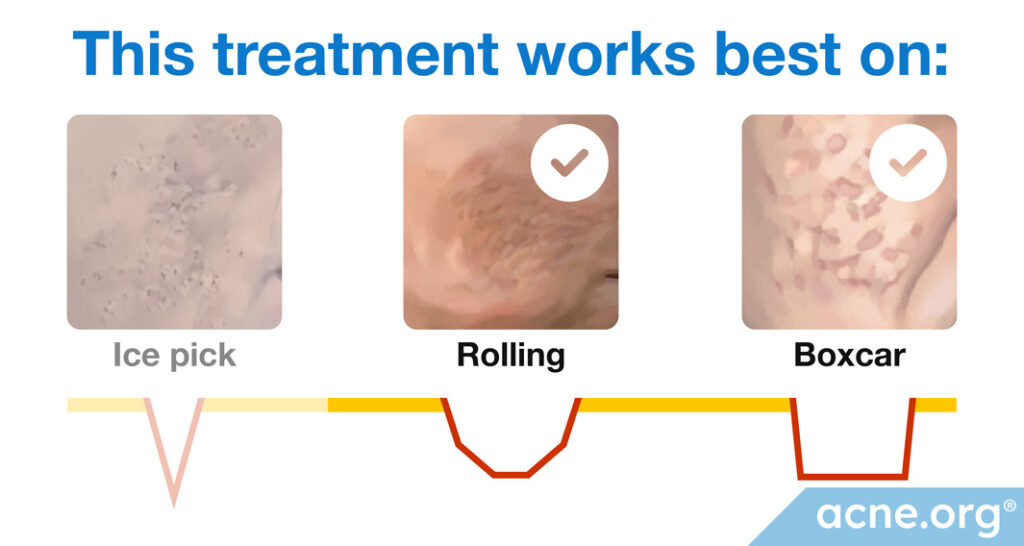
* Fractional CO2 laser with PRP works best on boxcar and rolling scars.
Fractional carbon dioxide (CO2) laser consists of shining an intense beam of light onto the skin in a dot matrix pattern. Because the light is concentrated and intense, it causes controlled damage to the skin in this same dot matrix pattern. Areas of skin in-between the pinpoints are left untouched, which shortens healing time.
Lasers can be ablative or non-ablative. Ablative lasers completely ablate (remove) the surface of the skin, whereas non-ablative lasers create a controlled injury deep in the skin, but do not ablate the surface of the skin.
Lasers can also be fractional or non-fractional. Fractional lasers, also known as fractionated lasers, deliver many small pinpoints of laser light in a grid-like pattern, so that areas of skin in-between the pinpoints are left untouched. Because only a small portion of the skin is damaged, healing time is shorter than with non-fractional lasers, which do not use a grid-like pattern and instead deliver light onto an entire section of skin.1
Fractional CO2 laser is a type of ablative laser. Ablative lasers work by quickly heating up water molecules in the epidermis (the upper layer of the skin), which essentially “vaporizes” this skin layer. Because ablative lasers completely remove the epidermis in a dot-matrix pattern and trigger it to regrow, they can achieve better results than non-ablative lasers as well as some other scar repair methods, but they also come with a long recovery time and a relatively high risk of side effects.1
Fractional CO2 lasers are now often combined with platelet-rich plasma (PRP). Platelet-rich plasma contains growth factors that further stimulate the formation of tissue beneath the skin’s surface by helping cells to produce collagen and elastin. Additionally, PRP enhances the skin healing process and shortens recovery time after the procedure.2
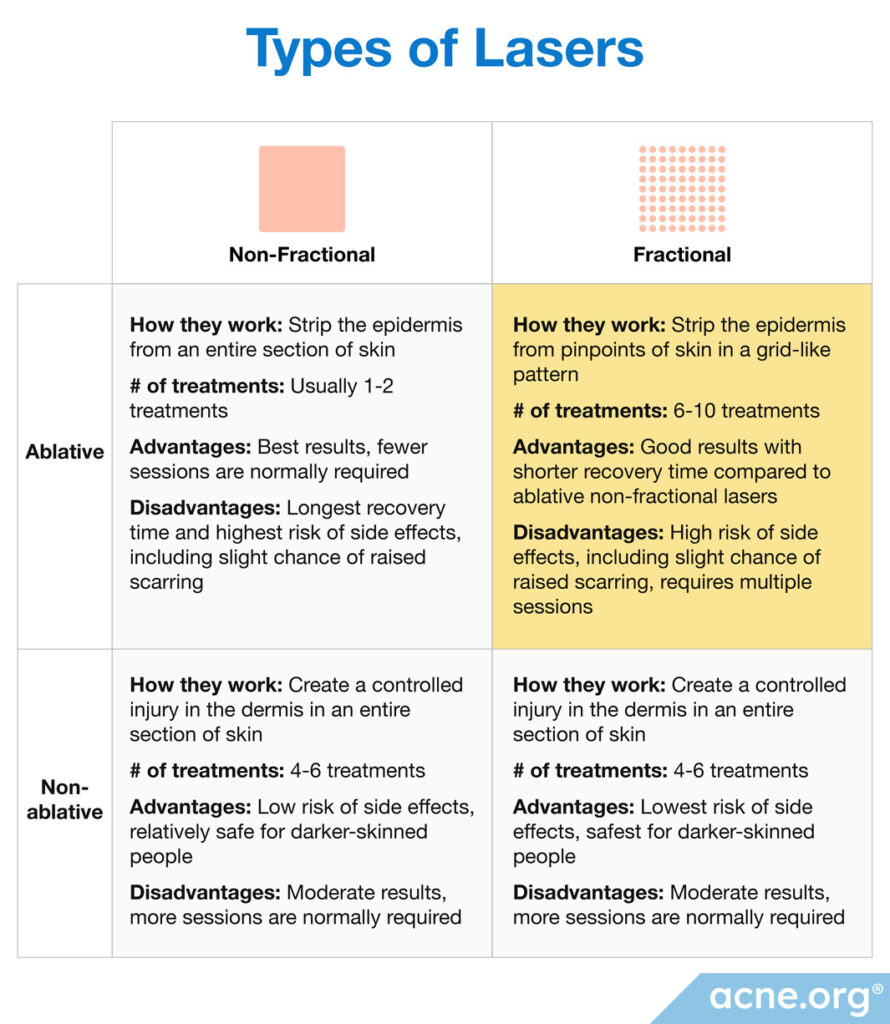
Fractional CO2 laser with PRP:
- How it works: Strip the epidermis from pinpoints of skin in a grid-like pattern. PRP stimulates the skin to produce collagen and elastin and shortens skin recovery time after laser treatment
- # of treatments: 3 treatments at 1-month intervals
- Advantages: Good results with shorter recovery time compared to ablative non-fractional lasers1
- Disadvantages: Higher risk of side effects compared to some other scar treatments, including raised scarring (relatively rare when the procedure is performed correctly), requires multiple sessions1
- To minimize the risk of scarring, it’s crucial to choose an experienced and qualified practitioner for the procedure. If you’re considering ablative laser resurfacing, it’s important to discuss all potential risks and benefits with a dermatologist or a cosmetic skin care specialist. They can provide guidance based on your skin type, medical history, and the specific concerns you’re looking to address with the treatment.
CO2 stands for carbon dioxide, which is the medium by which the laser beam is created.
Each laser subtype penetrates the skin to a different depth. In general, ablative lasers cause more damage to the skin compared to non-ablative lasers, but do not penetrate as deep into the skin, whereas non-ablative lasers are less damaging, but penetrate into deeper skin layers. CO2 lasers penetrate the entire epidermis but not into the dermis.
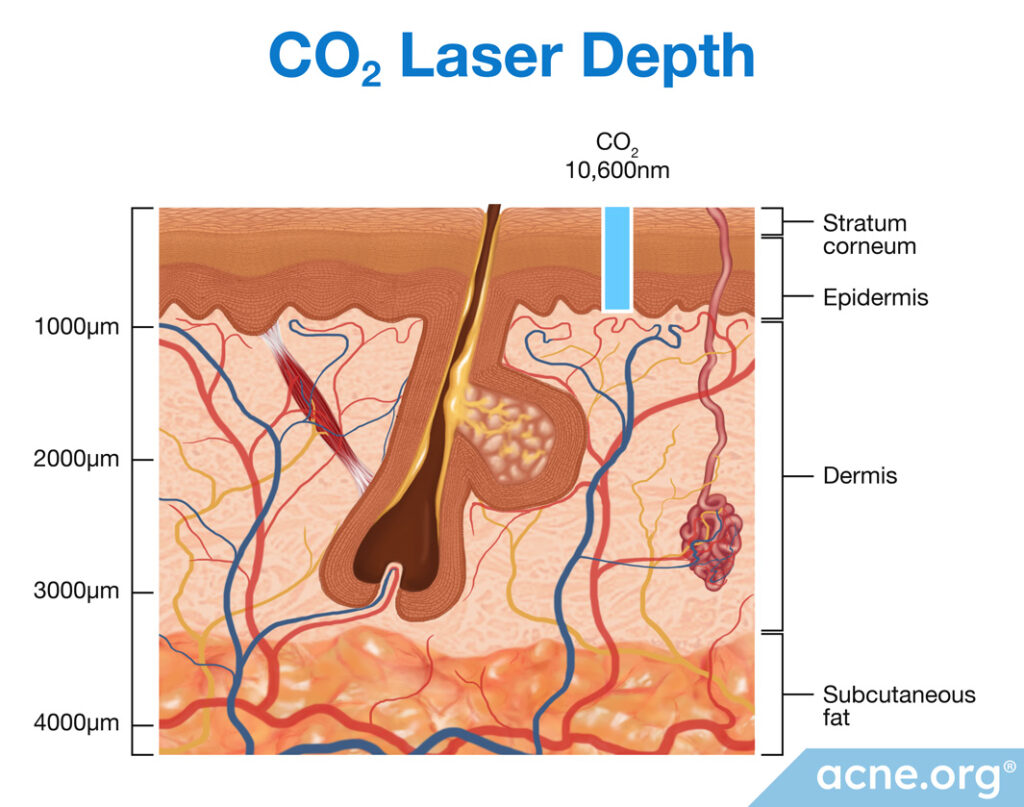
People with active acne should not undergo acne scar repair of any kind, including fractional CO2 laser with PRP. Make sure your skin is completely clear of acne before beginning scar treatment.
Fractional CO2 laser with PRP cannot be performed while there is an active skin infection or skin condition such as a bacterial infection, eczema, or psoriasis. Ensure your skin is clear before seeking laser resurfacing.
Doctors do not recommend undergoing any laser scar treatment for 6 months after taking oral isotretinoin (Accutane®), because during this time the skin may respond unpredictably to laser treatment.4
If you have a history of keloid scarring, approach laser resurfacing with caution. You may have a higher chance of developing keloid scars as a side effect of laser resurfacing.3,4
Patients with darker skin are at increased risk of pigmentation (skin coloring) due to laser treatment, especially hyperpigmentation (skin darkening).
Before agreeing to undergo fractional CO2 laser with PRP treatment, discuss your treatment options, expected outcomes, and treatment prices with multiple doctors.
Procedure details:
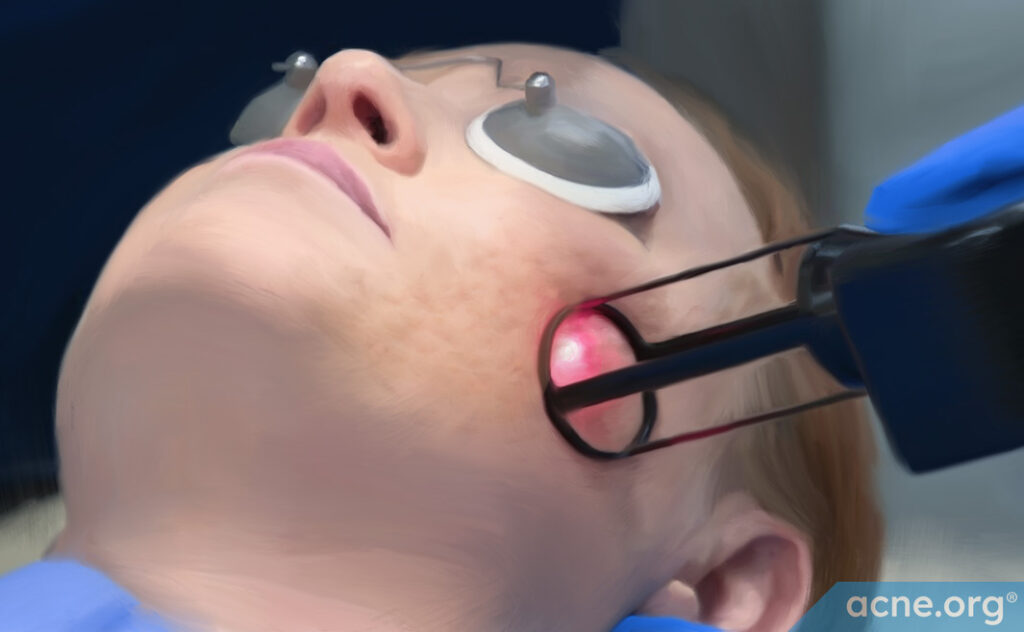
Before booking your treatment, your doctor should first schedule a session to discuss the procedure, expected results, and possible complications with you and to answer your questions.
Your doctor may prescribe antiviral medications for you to take before the procedure in order to prevent a viral skin infection from developing after treatment.5
Fractional CO2 laser with PRP treatment is usually performed in an outpatient setting.
First, you will receive laser resurfacing. During the laser resurfacing portion of the treatment, you will be given protective eyewear to prevent the laser from damaging your eyes.
A medical professional will fine-tune the laser settings in order to get the best results while minimizing recovery time and side effects.
Although all ablative lasers cause skin damage, the damage can vary significantly depending on several variables. One of these variables is the wavelength that the laser material creates:
- Wavelength: CO2 fractional laser uses 10,600 nm wavelength. The wavelength of a laser is a number in nm (nanometers) corresponding to a specific color of light. Most lasers used for skin resurfacing emit colors of light that are invisible to the human eye, so you will not be able to see the laser beam during your treatment. Generally speaking, the higher the wavelength, the higher the potential for skin damage. CO2 lasers have a high wavelength, which is why they completely ablate the skin.
Other settings that determine how much damage a laser causes can be controlled by the medical professional:
- Delivered fluence, also known as energy density: Fluence or energy density is a measure of how much energy the laser delivers per unit area of the skin–in other words, how intense the laser is. The fluence needs to be set high enough to cause a controlled injury to the skin, but not so high as to create unnecessary damage. The medical professional may need to set the fluence higher to target a particularly strong or large structure, like a severe or wide scar. Delivered fluence only depends on the laser’s settings, not on the type of laser.5
- Pulse duration: Normally, the light from a laser is delivered in a series of short bursts, called pulses, with short breaks in-between. Pulse duration is a measure of how long each pulse lasts. The longer the pulse, the more skin damage it causes, so this is another setting that the doctor needs to carefully fine-tune in order to obtain the best results and minimize the side effects. Just like delivered fluence, pulse duration only depends on the medical professional’s settings, not on the type of laser.5
Platelet-rich plasma (PRP) procedure:
Immediately after laser resurfacing, PRP is either topically applied or injected into the skin.
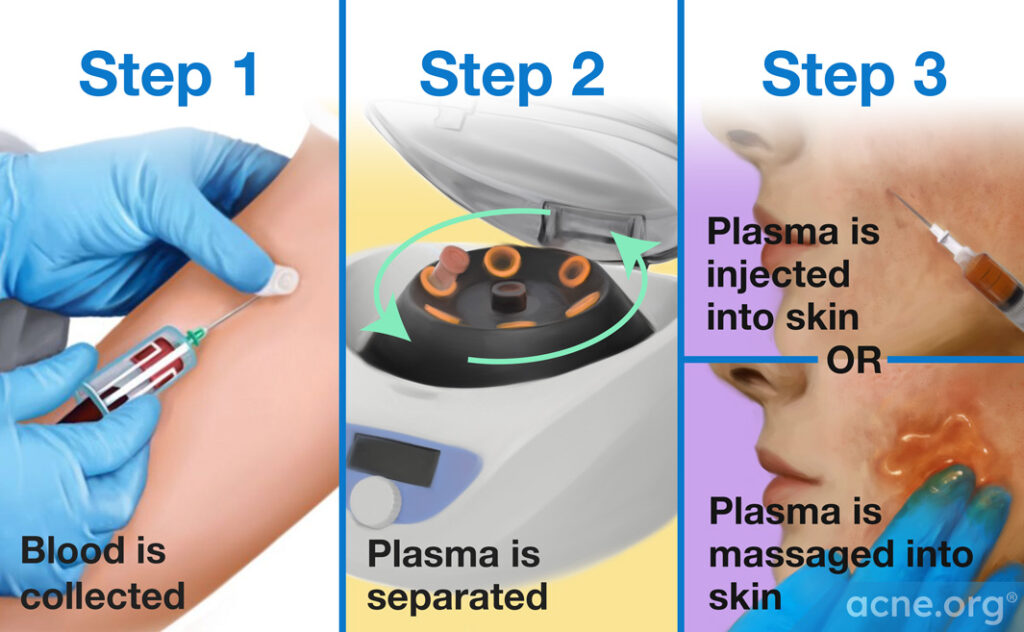
The first part of the procedure is getting platelet-rich plasma from the patient. To do that, a medical professional will collect a small amount of blood from your arm. Your blood is then placed in a machine called a centrifuge, to separate plasma from the rest of the blood. Plasma contains high levels of platelets and growth factors, which is why it will be extracted and used for acne scar treatment.6
A medical professional will apply the plasma to the treated area by massaging it into the skin or injecting it directly into the skin.7
Anesthesia:
Laser scar treatment can be uncomfortable and even painful. To numb your skin before the procedure, a medical professional may:
- Apply a topical anesthetic to your skin 30-60 minutes before the treatment
- Provide you with a topical anesthetic to apply to your skin before you arrive at the medical facility for your treatment
- Inject a local anesthetic into the treated area of the skin before beginning treatment if only a small portion of the skin needs to be anesthetized. (For small treatment areas)
Before-and-after:
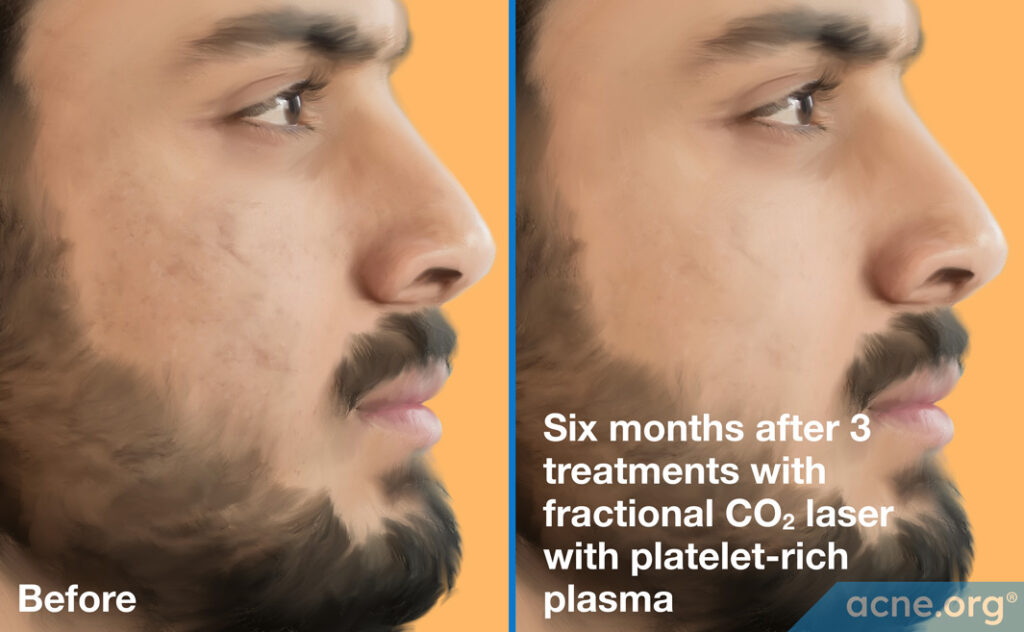
Acne scars before and immediately after 3 treatments with CO2 fractional laser and PRP.
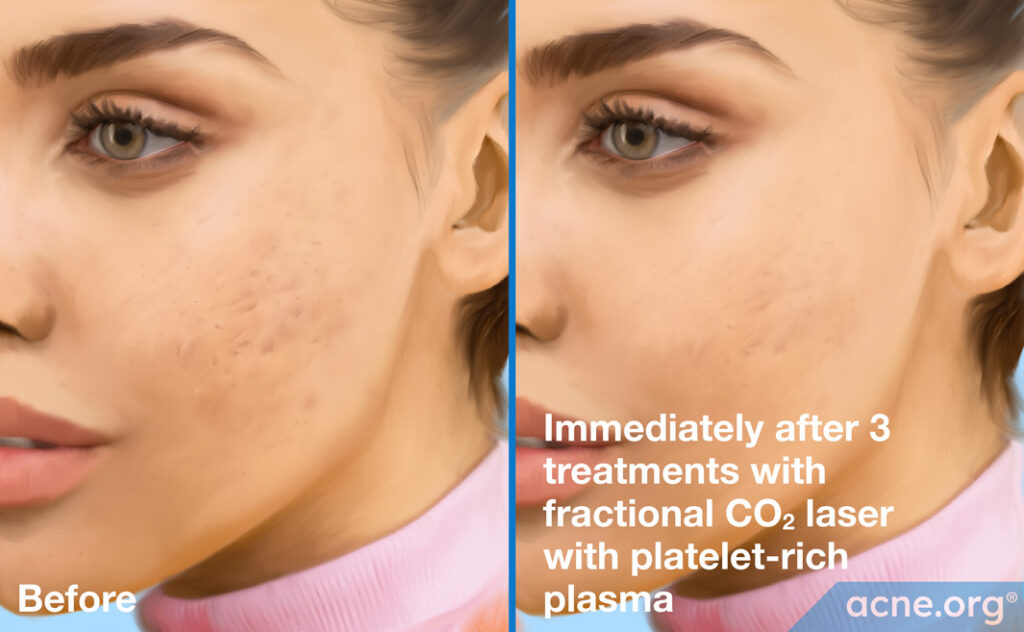
Acne scars before and 6 months after 3 treatments with CO2 fractional laser with PRP.
References
- Preissig J, Hamilton K, and Markus R. Current laser resurfacing technologies: A review that delves beneath the surface. Semin Plast Surg. 26(3), 109–116 (2012).
- Min S, Yoon JY, Park SY, Moon J, Kwon HH, Suh DH. Combination of platelet rich plasma in fractional carbon dioxide laser treatment increased clinical efficacy of for acne scar by enhancement of collagen production and modulation of laser-induced inflammation. Lasers Surg Med. 50(4), 302-10 (2018).
- Avram MM, Tope WD, Yu T, Szachowicz E, Nelson JS. Hypertrophic scarring of the neck following ablative fractional carbon dioxide laser resurfacing. Lasers Surg Med. 41(3), 185-8 (2009).
- Sobanko JF, and Alster TS. Management of acne scarring, part I: a comparative review of laser surgical approaches. Am J Clin Dermatol. 13(5), 319-30 (2012)
- Uptodate.com. Management of acne scars. Available from: https://www.uptodate.com/contents/management-of-acne-scars?source=search_result&search=subcision&selectedTitle=1~4.
- Cleveland Clinic. Platelet rich plasma. Available from: https://my.clevelandclinic.org/health/treatments/21102-platelet-rich-plasma#procedure-details
- Asif M, Kanodia S, Singh K. Combined autologous platelet-rich plasma with microneedling verses microneedling with distilled water in the treatment of atrophic acne scars: a concurrent split-face study. J Cosmet Dermatol. 15(4), 434-43 (2016).
- El-Hawary EE, Nassar S, Hodeib AA, Shareef MM, Fawzy MM. Ablative Fractional Carbon Dioxide Laser and Autologous Platelet-Rich Plasma in the Treatment of Atrophic Acne Scars: A Comparative Clinico-Immuno-Histopathological Study. Lasers Surg Med. 53(4), 458-67 (2021).
- Arsiwala NZ, Inamadar AC, Adya KA. A Comparative Study to Assess the Efficacy of Fractional Carbon Dioxide Laser and Combination of Fractional Carbon Dioxide Laser with Topical Autologous Platelet-rich Plasma in Post-acne Atrophic Scars. J Cutan Aesthet Surg. 13(1), 11-17 (2020).
 Acne.org Products
Acne.org Products